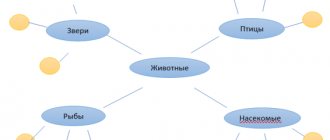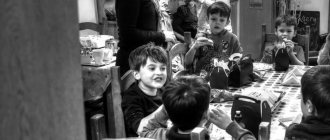LEGO - design and robotics in preschool educational institutions.
LEGO - design and robotics in preschool educational institutions.
Currently, new games and entertainment have appeared in the education system of preschool children. Children easily master information and communication technologies, and it is difficult to surprise them with traditional visual means. The development of the educational process goes in many directions, affecting mainly the formation of the personal qualities of a preschooler. The result of the educational activities of preschool educational institutions today is considered not the sum of knowledge, skills and abilities, but the personal qualities acquired by the child: curiosity, activity, independence, responsibility and good manners.
We, teachers, strive to use a variety of techniques and methods, realizing that we ourselves must learn modern technologies, because our students live in a world of computers, the Internet, electronics and automation. They want to see this in educational activities, to study, use, understand. One of these modern methods is considered to be joint (preschoolers, teachers and parents) integration activity - Lego construction.
Every child is a born designer, inventor and researcher. These tasks inherent in nature are especially quickly realized and improved in constructive activities. Construction is a very interesting and exciting activity; it is closely connected with the intellectual development of a child.
This type of activity is distinguished by its novelty in the use of Lego, a construction set with which the child has the opportunity to communicate, explore and play.
The construction set helps children bring their ideas to life, build and imagine, working with passion and seeing the end result. Lego encourages both your head and your hands to work equally. Lego is always a new discovery, a new idea. A new impetus for development.
Children who are interested in design are distinguished by rich fantasy and imagination, an active desire for creative activity, a desire to experiment and invent; They have developed spatial, logical, mathematical, associative thinking, memory, and this is the basis of the child’s intellectual development.
Construction is closely related to the sensory and intellectual development of a preschooler. It is of particular importance for improving visual acuity, accuracy of color perception, tactile qualities, development of small muscles of the hands, perception of the shape and size of an object, space. Children try to establish what an object is like and how it differs from others; master the ability to measure the width, length, height of objects; begin to solve constructive problems “by eye”; develop imaginative thinking; learn to imagine objects in different spatial positions, mentally change their relative positions. In the course of classes, work is being done on the development of the intellect of imagination, fine motor skills, creative inclinations, the development of dialogic and monologue speech, and the expansion of vocabulary. Particular attention is paid to the development of logical and spatial thinking. Pupils learn to work with the proposed instructions, develop the ability to cooperate with a partner and work in a team.
MAGAZINE Preschooler.RF
Lego construction in kindergartenLego is the most popular game on the planet. The word Lego has two meanings: “I learn” and “I build . The British Toy Traders Association awarded the designer the title of “Toy of the Century” . Here is the characteristic that the world's best designer corresponds to:
- Unlimited game potential.
- Suitable for girls and boys.
- Suitable for all ages.
- Suitable for any season.
- Healthy and calm games.
- You can play for a long time.
- Develops imagination and creativity.
- The more Lego bricks, the better.
- The quality is visible in every detail.
The Lego constructor can be divided into two large classes: classic small Lego and large Lego Duplo.
Lego Duplo is intended for children from one and a half years old. There isn't a lot of variety in these sets - mostly rectangular and square bricks and plates. Many of the cars in this set come apart into two parts - a platform with wheels and the body of the car. Many sets have doors, windows, and fences.
Such elements greatly enliven the construction. Also, one of the advantages of these sets is the abundance of plastic men and animals that are attached to the plate. In addition, Lego Duplo has many educational sets designed to teach a child counting, the ability to build according to instructions, and letters.
Small Lego.
Lego Creator. It’s best to start introducing your child to classic small Lego with sets in this series. It contains a lot of thematic sets with all kinds of houses, cars, lighthouses, castles, and just boxes with cubes, windows with doors and tiles.
Lego City. There are only city-themed sets available here (police stations, fire departments, ambulances, trains, etc.)
Thematic sets. Lego tried to collect all the most popular hobbies of children in their thematic sets. There are series based on individual films and cartoons, all kinds of robots, transformer monsters, ninjas and spaceships.
Lego Ruckers are sets for assembling cars that have inertia mechanisms.
Lego Technician. These are very interesting and very complex kits, where models are assembled mainly not from bricks, but from all kinds of bushings, gears and sticks. Thanks to this, all models have moving, mechanized parts and give a good idea of how levers, pistons, gears work, and how machines work from the inside.
Lego Mindstroms. This is a multifunctional kit containing many sensors and programmable chips. Using it, you can assemble real robots and, most importantly, determine their behavior and create programs in a special programming language.
The themes of LEGO games are vast. We build cities, ships, look for treasures, and dramatize popular Russian folk tales. We enrich our vocabulary, expand our horizons, and discover the unknown. We actively combine gaming and educational activities.
The approach to learning does not cause hostility, the material is absorbed more easily, and the load on the body is reduced.
Children are tireless designers; they learn to design “step by step,” which improves their visual and figurative thinking.
Activities with Lego help children realize their ideas, build, fantasize, work enthusiastically and see the end result. All activities with Lego take place in the favorite “build and play” game form.
Light construction classes develop fine motor skills, imagination and logic. Composing a single object from construction blocks is a difficult but feasible task. An experienced teacher guides children along the path from simple to complex. During the Lego construction class, problems of a problematic nature are collectively solved, which affects the development of search activity; children are not afraid of mistakes, they know how to analyze them and with particular pleasure look for different ways to solve the same problem. At the end of each lesson, the finished design is played out in a plot.
Watching children aged 4-5 years making light constructions, I saw that playing with them was monotonous. All the children’s buildings were limited to the construction of turrets (who can build the highest) or simply piling parts on top of each other like a wall. Children could not combine familiar elements in a new way; creativity did not manifest themselves in the game. Playing with Lego was accompanied by low speech activity, both in explaining the planning and execution of the construction, and during the game, the vocabulary was poor, and the children did not voice their actions in the game. The plan was not completed, fine motor skills of the hands were poorly developed, many tried to forcefully press the parts in order to find the correct position for fastening, or resorted to rough fastening options: hitting them with a fist or palm.
All this encouraged me to study more deeply the methods of light construction for use in various fields.
After analyzing the observations, I determined the purpose of my further work.
Goal: to promote the development of technical creativity in preschool children, to provide them with the opportunity for creative self-realization through mastering LEGO construction.
Objectives: to form coherent speech, the ability to consistently and logically construct a speech utterance, enrichment of subject and verb vocabulary; to form a sustainable interest in constructive activities, the desire to create, invent; develop imagination, constructive imagination and the ability to creatively use acquired skills and create an attractive play situation that encourages children to develop their own ideas; cultivate friendly relationships, develop independence when working with schemes.
She also determined the expected result: during the work on light-duty construction, the child should know: the main details of the light-duty constructor (purpose, features); the simplest fundamentals of mechanics (stability of the structure, strength of the connection, types of connection of parts); name the details of a Lego constructor; technological sequence of manufacturing simple structures. Be able to: select the parts necessary for design (by type and color); design, focusing on a step-by-step scheme for manufacturing structures, according to a sample; work in pairs and in a small group of children; comment on actions with Lego elements, follow verbal instructions; use diagrams of a future building completed by LEGO.
In order for the work to bring greater results, I introduced parents to the importance of light construction in the lives of children and, most importantly, the importance of joint play between children and parents. Already at an early age, parents purchase beautiful games and toys for their children, including LEGO construction sets. But no matter how good they are, they cannot bring the benefit that can be obtained from them if mom or dad are not nearby. After all, even such a spectacular constructor as LEGO cannot replace parents for a child. While playing with LEGO together with parents, the child does not feel lonely, relationships are formed and strengthened, and a sense of self-confidence develops. In a playful form, children can more easily automate sounds, broaden their horizons, and expand their vocabulary. And during the workshop meeting, the parents themselves played the role of creators. Using the diagram to write a story about a future building, they shared their idea, and after construction, the diagram helped them write a story about playing with Lego buildings. I was glad that the parents did not have any difficulties in this, because they are the ones who are a model of competent speech for the child and an incentive to increase speech activity. At this meeting, we decided to diversify and replenish the Lego constructors by purchasing Lego DUPLO sets.
For successful work, I planned a long-term plan for light construction, including it in educational activities, in independent activities, in didactic games, not forgetting to use it in various educational areas. We organized exhibitions for parents “Miracle Christmas Tree” , putting all the emotions into the work after the New Year's party, helped return animals to the zoo after a trip to Africa, made buildings for pets and their homes, shared our experience of building LEGO crafts and playing with them with younger children groups, learned to lay out beautiful patterns from Lego pieces using a model and solve simple examples. And funny Lego men helped us get acquainted with the characteristics of sounds, find their place in a word and help us learn to read. With Lego, it is easier for us to remember numbers and letters, laying them out according to a pattern and later from memory.
At the end of the middle group, children freely used words from the vocabulary in their speech, taking into account the size of the parts (names of the parts, supplemented them with definitions (Green medium brick, red cube)) were able to build elementary buildings according to a creative plan, according to a model. Not everyone has developed the ability to build according to a diagram due to insufficient attention span. It was more difficult for some children to write a story about their work, but we continued to work on this in the older group. I think that the difficulty in this arose due to age-related speech impairments, since not all children are able to At this age they mastered the system of their native language.Working in pairs took place in a calmer environment, the children learned to negotiate with each other and share details while working.
How to play Lego.
For many, like me, Lego is associated with construction according to instructions. Until the age of 8-12, a child is unlikely to build according to instructions. That is, if he wants and is interested, then please. But if he is indifferent to the amazing buildings that Lego designers offer, then that’s great too. During this period, the development of creativity and imagination is much more important than the development of spatial thinking (which is activated when assembling according to instructions).
Adults and children must play without instructions, making structures on the fly. Lego is very similar to clay or plasticine - you can make anything, crush it into a ball and make something completely different.
However, once you buy a new set, you should definitely assemble it according to the instructions. For what? To see and understand all the possibilities of the parts. Pay attention to the strength of the building, show how to lay bricks crosswise, how to press the parts so that they fit tightly and how to separate them (without using teeth).
Lego is creativity and it’s good when it’s free from templates and samples!
Practical part.
Offer a small identical Lego set. (3 cubes, 3 bricks). Ask to build a duck (without a sample) without peeking at each other. As a result of one task, all the ducks are different. This is the creative imagination of every person. If someone modeled an inverted duck (that is, with the cube buttons down and the tubes up), then this person has unconventional thinking.
Conclusion: each child has his own vision of the world, an imagination that needs to be developed.
Make up your own story.
Divide into creative groups. Offer construction sets and plates. Give a task: a few words. You need to come up with and build a story with these words. For example: words (cat, bridge, fear). Parents model a story with these words. For example:
“Once upon a time there was a cat. One day he climbed onto a high bridge and became very scared. Rescuers arrived and removed him from the bridge.
The next group has a different story. Stories can be united by one character.
At the end of the master class on Lego construction, we decided: to develop the creative abilities and design skills of children, to educate individuals who are able to independently set problems for themselves and solve them, finding original ways to solve them.
| Next > |
Robots Education Creativity
Details Published: 10/06/2017 00:05 Probnyak V.V., Satybalova A.A.
MBDOU "Kindergarten "Zvezdochka", Novy Urengoy
Yamalo-Nenets Autonomous Okrug
“By constructing, the child acts like an architect erecting the building of his own potential.”
J. Piaget
The state is currently experiencing an urgent need for highly qualified specialists with high intellectual capabilities. Therefore, it is so important, starting from preschool age, to form and develop technical inquisitive thinking, an analytical mind, and to form the personality qualities designated by federal state educational standards.
At the present stage of preschool education, the emphasis is shifted from knowledge, skills and abilities to the formation of mental processes and the development of the child’s personal qualities, such as curiosity, determination, independence, responsibility, creativity, which ensure social success and contribute to the formation of an intellectual creative personality. Raising a harmonious, comprehensively developed personality is one of the most important government tasks, the implementation of which is aimed at improving the education system, methods of education and training. The issue of using pedagogical development technologies in preschool organizations in terms of training a person of this kind is relevant [1].
One of the innovative technologies aimed at developing the intellectual and personal qualities of preschool children, developing technical abilities, design skills, and nurturing a creative personality capable of independently setting tasks and finding original solutions is educational Lego technology.
Results of modern psychological and pedagogical research (Yu.K. Babansky, L.A. Venger, N.A. Vetlugina, N.N. Poddyakov, I.D. Zverev, V.V. Zaporozhets, I.Ya. Lerner, A .I. Savenkov, GI Shchukina, etc.) show that the possibilities of intellectual development of preschool children are much higher than previously assumed. Thus, it turned out that children can successfully learn not only the external, visual properties of objects and phenomena, but also their internal connections and relationships. Then, when during this sensitive period the abilities for initial forms of generalization, inference, abstraction are formed, the special value of this technology is that practically, through direct activity, the hidden sides of an object or phenomenon are revealed; the child’s ability to define a problem, perform analytical operations, and the ability to independently choose a way to solve it develops [2].
Constructive activities, Lego design classes, are given a lot of attention in the implementation of general education programs of preschool educational organizations. However, as a rule, teachers encourage the child to engage in constructive activities aimed at developing fine motor skills in early preschool age. However, the resource of performing multiple manipulations during classes in Lego construction, robotics, during real experiments using laboratory equipment, can serve as the basis not only for the development of motor skills, stimulating the development of a child’s sensory abilities, but also a fairly high motivation factor for intellectual activities. activities, experimentation, design, technical creativity, starting from early preschool age [3].
Traditionally, the constructive activities of children of senior preschool age are more often organized in free activities (of the nature of plot construction) and less often in specially organized ones. The idea of making Lego construction in kindergarten a guided process, rather than a spontaneous one, formed the basis for the systematic work of the team of the municipal budgetary preschool educational institution “Zvezdochka Kindergarten” in the city of Novy Urengoy, Yamalo-Nenets Autonomous Okrug.
For several years, the institution has been working towards the development of constructive activities and technical creativity through the use of Lego technology and educational robotics, and is a resource center for the Russian Association of Educational Robotics (RAOR Moscow). In network interaction with municipal educational institutions of the city of Novy Urengoy: MBOU DO House of Children's Creativity and MBOU Secondary School No. 17 functions as a regional innovation platform. The results of the implementation of such activities allow us to draw conclusions about the effectiveness of using the above-mentioned technology in the conditions of continuous continuous education.
The organization and content of the process of interaction between teachers and students to develop their intellectual potential using Lego technology is determined by conceptually new approaches aimed at the effectiveness of this process:
1.The introduction of educational light construction into joint educational activities (JED), in scheduled moments, in independent activities during the day, in accordance with the calendar-thematic work plan. Design classes are creative in nature. They are aimed primarily at developing the child’s individuality and his creative potential; classes are based on the principles of cooperation and co-creation of children with the teacher and with each other. To develop children's interest in constructive activities, teachers use entertaining experimental games, fantasy games, and various forms of organizing children's design education: design according to a model, according to a model, according to conditions, according to the simplest drawings and diagrams, according to a plan, according to a theme. For Lego construction classes, a bank of diagrams is created for children of different ages (the diagrams are combined into thematic blocks), a card index of game exercises and didactic games for the development of logical thinking using Lego constructors. Children begin to engage in Lego construction, as a rule, from the younger and middle groups. The inclusion of children in systematic design activities at this stage can be considered one of the important conditions for the formation of the ability to perceive the external properties of the objective world (size, shape, spatial and dimensional relationships).
Being built on integrative principles, Lego technology makes it possible to ensure the unity of educational, developmental and training goals and objectives of the educational process for preschool children. It is of great importance for improving visual acuity, accuracy of color perception, tactile qualities, development of small muscles of the hands, perception of the shape and size of an object, space. Children try to establish what an object is like and how it differs from others; master the ability to measure the width, length, height of objects; begin to solve constructive problems “by eye”; develop imaginative thinking; learn to imagine objects in different spatial positions, mentally change their relative position. In the process of creative activities, work is carried out on the development of intelligence, imagination, fine motor skills, creative inclinations, dialogical and monologue speech, expansion of vocabulary, and the formation of logical and spatial thinking. Children learn to work with the given instructions, develop the ability to cooperate with a playing partner, and work in a team. In the process of Lego construction, preschoolers develop mathematical abilities by counting parts, blocks, fasteners, calculating the required number of parts, their shape, color, length. Children become familiar with such spatial indicators as symmetry and asymmetry, orientation in space, visual acuity, perception of color, shape, size are improved, and mental processes (analysis, synthesis, classification) are successfully developed. Lego construction also develops communication skills, activating the mental and speech activity of preschoolers. Older preschoolers are happy to talk about their buildings, pronounce the sequence of their actions, and evaluate this or that constructive situation. They perform tasks that require activation of mental activity, for example, completing a building according to a given sign or conditions (“Fill the space”, “Guess whose part I am?”, “Bring your model to life” and others). Speech situations that arise in the process of creating buildings and playing with them contribute to the development of children's speech, which serves as one of the most important means of human activity, and for the future schoolchild is the key to successful learning at school.
One of the main opportunities of light construction is the development in children of the ability to work effectively together. Today, the joint acquisition of knowledge and development of skills, the interactive nature of interaction are in demand more than ever before. In a group activity, children can not only communicate, but also exchange tips on mounting methods, parts, or even combine their models to create a larger structure. It is important to organize conditions under which participants in joint activities could solve emerging problems by communicating and consulting with each other, as well as learn from their mistakes. At the same time, preschoolers develop social skills: independence, initiative, responsibility, mutual understanding, necessary when interacting with other children.
Construction activities help preschoolers enter the world of social experience. Children develop a unified and holistic idea of the objective and social world. The lesson plan includes topics such as “Animals”, “Urban and rural buildings”, “Furniture”, “Toys”, “Transport”, “Ships explore the Universe”, “Journey to a fairy tale” and others. By engaging in light construction during joint educational activities during the day, children acquire work culture skills: they learn to maintain order in the workplace, distribute time and effort when making models, and, therefore, plan activities.
2.Organization of a developmental space that promotes constructive activity: equipping preschool groups with interactive whiteboards with PervoRobot LEGO WeDo software (a set of interactive tasks), new generation Lego construction sets, including robotic ones (Lego-DUPLO, Lego-WEDO, Lego-constructor “First structures”, Lego construction set “First Mechanisms”, thematic Lego construction sets – airport, municipal transport, farm, wild and domestic animals, etc.).
3.Creation of a “smart” educational environment - the functioning of the Technopark as a platform for intellectual leisure for preschool children of all municipal preschool organizations of the city, equipped with interactive complexes, interactive tables, modern educational games, laboratory equipment for organizing research activities, Lego constructors, including programmable ones.
4.Introduction of partial programs in the areas of technical creativity, implemented as additional education for children from 4 to 7 years old: “Young Builder” (4-5 years old), “School of Little Wizards” (5-7 years old), “Lego Animators” ( 6-7 years).
5.Organization of educational excursions to LEGO classes of MBOU Secondary School No. 17.
6.Creation of “dialogue” interaction with the families of pupils (the work of the parent Club “Clever Kids” and the family workshop “Our hands are not for boredom” have been organized, which allows motivating the parents of pupils to expand the boundaries of family educational leisure).
The effectiveness of this system in the practice of work of the MBDOU DS Zvezdochka is obvious - the following indicators of the quality of preschool education have been achieved for the pupils of the institution: the level of readiness of pupils for school has increased (the proportion of children with high and above average levels of development of cognitive (mental) processes for the current three academic years has increased by 10-15%); children and parents have developed motivation to engage in research and constructive activities, technical creativity (increased by 25% compared to the initial indicators); a consistently positive image has been formed regarding preschool educational institutions in the educational services market in the city and district (the indicator of parents' satisfaction with the educational activities of preschool educational institutions has increased to 98%, 10% higher than the data for the previous three academic years).
Thus, we can conclude that, due to its versatility, the LEGO construction set is an effective developmental material; Lego technology used in preschool education makes it possible to diversify the learning process for preschoolers and improve the quality of educational services provided.
Used Books:
1. Ishmakova M.S. Design in preschool education in the context of the introduction of the Federal State Educational Standard: a manual for teachers. – M.: IPC “Mask”, 2013. (p. 117)
2. Kudryavtsev V.I. Innovative preschool education: experience, problems and development strategy. /Preschool education. – 2015. – No. 12. (p.61-68)
3. Feshina E.V. Lego construction in kindergarten. Methodological manual - M.: Sphere shopping center, 2016. (p. 24)






